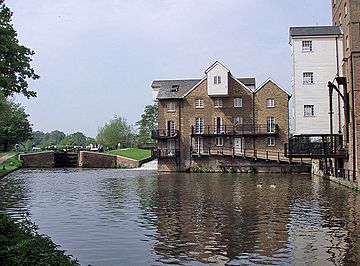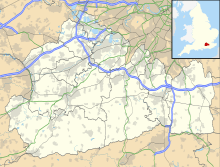Coxes Lock facts for kids

Coxes Lock and Mill, River Wey, Surrey.
|
|
| Waterway | River Wey and Godalming Navigations |
|---|---|
| Country | England |
| County | Surrey |
| First built | 1651 |
| Latest built | 1770 |
| Fall | 2.59 m |
| Coordinates | 51°21′59″N 0°28′37″W / 51.366375°N 0.477036°W |
Coxes Lock is a special water gate located on the Wey Navigation in Addlestone, Surrey, England. It's found near the northern end of this waterway, running alongside the River Wey.
Most of the Wey Navigation is made up of canal sections, like the one at Coxes Lock. These sections usually get their water from locks opening, small ditches, and rainfall. Coxes Lock is known for its nearby mill buildings, which are now apartments. There's also a path for walking and a large pond called the Mill Pond. This pond helps control the water level for the lock and the old mill.
Contents
What is Coxes Lock and Why is it Important?
Coxes Lock was built a long time ago, between 1651 and 1653. It was a key part of a route used to move heavy goods between London and Guildford by boat. In 1770, the lock was improved, and a stone was placed there to mark the date.
Coxes Lock is the deepest lock on the Wey Navigation that doesn't have a person operating it all the time. It helps boats move up or down by about 2.59 meters (8 feet 6 inches). It's also quite close to the River Thames, about 2.4 kilometers (1.5 miles) away.
The Story of Coxes Lock Mill
In 1776, a businessman named Mr. Cox saw how useful this place could be. He started building an iron mill here, which became known as Coxes Lock Mill. This mill was very important for making things from iron.
From Iron to Flour: Changes at the Mill
The mill had three main buildings, named Alexander Raby Mill, Daniel Lambert Mill, and John Bunn Mill. For 207 years, these buildings were used for both industrial work and as homes. Today, they have been turned into apartments, but a part of the original mill has been kept to show its history.
Coxes Mill was the last working mill in Surrey when it closed on April 8, 1983. Surrey used to have many mills, even back in the medieval period. These mills used water power to grind grain and later to make paper and metal.
The mill got its power from a large waterwheel, which used water from the local streams and the big Mill Pond. The Mill Pond was made extra large to make sure there was always enough water, even when the lock was being used or the mill was running.
Over time, the mill changed what it produced. In 1808, the mill's lease was taken over by John Bunn, who changed it to produce flour in the 1830s. For a short time, the mill even had a silk weaving business!
Modernizing the Mill
Towards the end of the 1800s, Coxes Mill was doing well enough to invest in new technology. It became one of the most important industrial buildings in the country. The mill was rebuilt in 1901 and made even bigger in 1906.
Eventually, new machines and powerful engines replaced water power. The mill started using steam power, and then electricity. By the mid-1960s, a tall wheat silo was built, and another flour silo was added in 1969. The mill joined with Allied Mills and was producing 60 tonnes of flour every day!
What's Around Coxes Lock Today?
Most of the land around Coxes Lock is owned by the National Trust. This area includes water and meadows, which act as a green space near London. After the mill closed in 1983, the entire Wey Navigation was given to the National Trust.
The three old mill buildings are now listed as important historical or architectural sites. They have been turned into apartments and are in a quiet, green area. The large Mill Pond is home to many types of fish, dragonflies, and other insects. The apartment complex also has a gym and swimming pool for residents.


